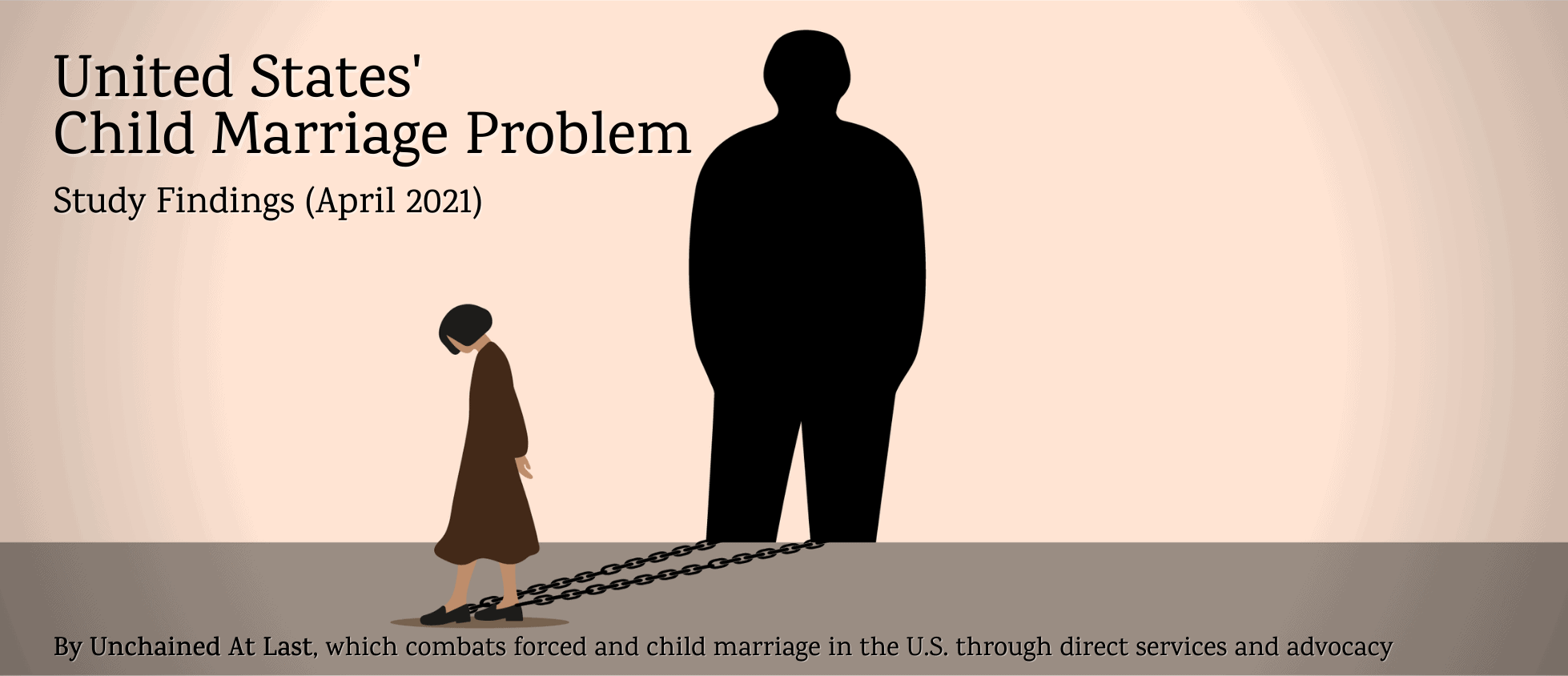
Also see our article in the Journal of Adolescent Health!
The United States has a child marriage problem – but a simple solution is available.
Nearly 300,000 minors, under age 18, were legally married in the U.S. between 2000 and 2018, this study found. A few were as young as 10, though nearly all were age 16 or 17. Most were girls wed to adult men an average of four years older.
Child marriage – or marriage before age 18 – is dangerous. Even at age 16 or 17, regardless of spousal age difference, child marriage:
1. Can easily be forced marriage, since minors have limited legal rights with which to escape an unwanted marriage (typically they are not even allowed to file for divorce);
2. Is a human rights abuse that produces devastating, lifelong repercussions for American girls, destroying their health, education, economic opportunities and quality of life; and
3. Undermines statutory rape laws, often covering up what would otherwise be considered a sex crime. Some 60,000 marriages since 2000 occurred at an age or spousal age difference that should have been considered a sex crime.

Unlike in countries where child marriage is illegal but persists anyway, the problem in the U.S. is the laws themselves. Most U.S. states still allow marriage before 18, and the four states* that banned it did so only in the last three years.
Federal law, too, allows and might even encourage child marriage. Immigration law does not specify a minimum age to petition for a foreign spouse or fiancé(e) or to be the beneficiary of a spousal or fiancé(e) visa, which allows for American girls to be trafficked for their citizenship and allows for children around the world to be trafficked to the U.S. under the guise of marriage. The U.S. approved nearly 9,000 petitions involving a minor between 2007 and 2017, and in 95% of them, the younger party was a girl. Further, the federal criminal code prohibits sex with a child age 12 to 15 but specifically exempts those who first marry the child. This incentivizes child marriage and implicitly endorses child rape.
Legislation to this effect harms no one except child rapists, costs nothing and protects children from a human rights abuse.
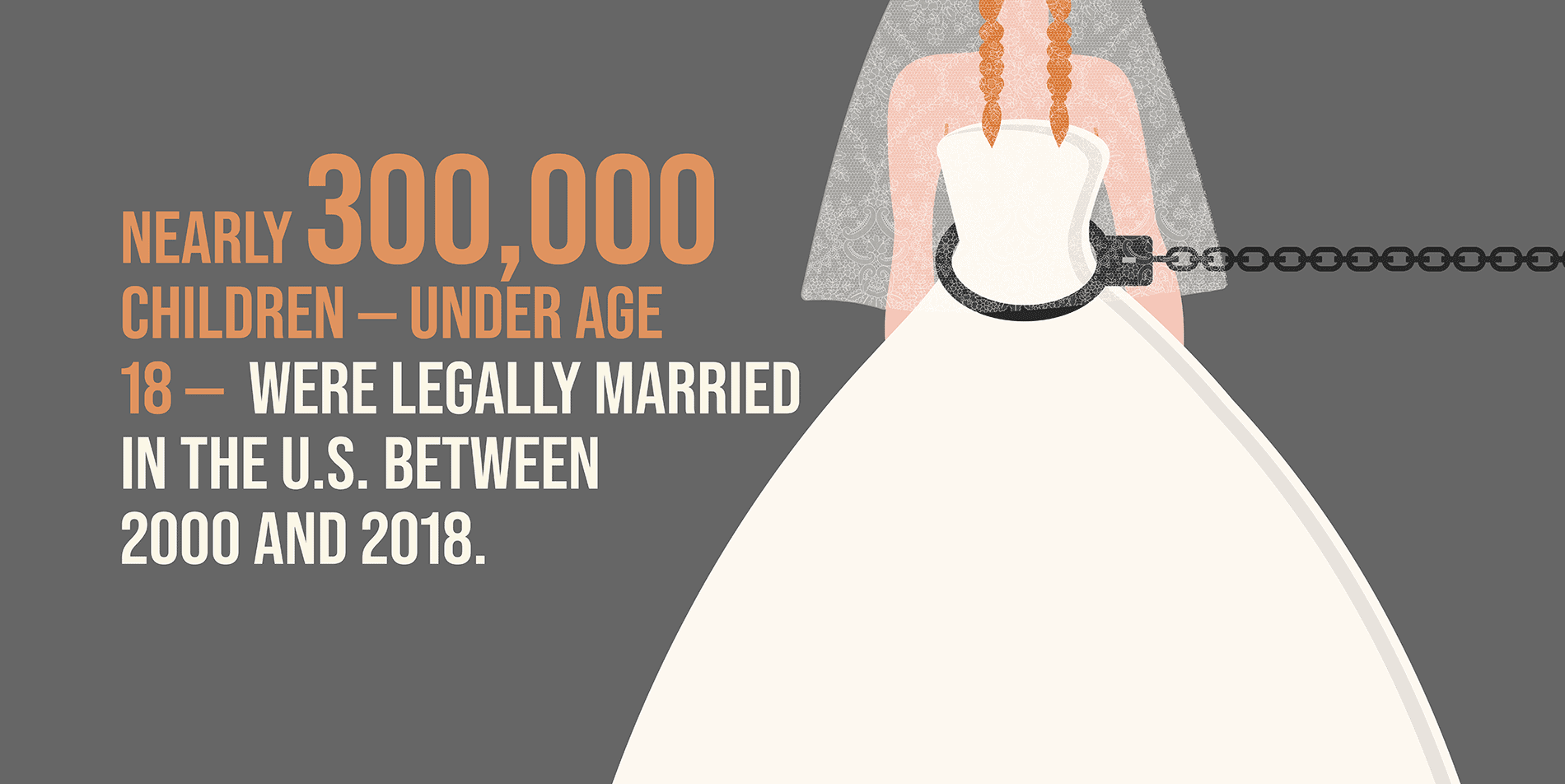
Unchained At Last first realized in 2015 that the U.S. has a child marriage problem. Unchained had been founded in 2011 by a forced marriage survivor with a mission of providing free legal and social services to help individuals in the U.S. to escape forced marriages – but more and more girls, under age 18, were reaching out to Unchained to plead for the same help.
At the time, child marriage was legal in all 50 U.S. states, a fact that seemed lost on policymakers and advocates. Yet there is almost nothing Unchained can do to help a girl who is not yet 18 to escape a forced marriage. Even a day before her 18th birthday, a girl in the U.S. typically cannot leave home, enter a domestic violence shelter or even file for divorce.
Unchained launched a national movement to end child marriage with an op-ed article in the New York Times titled “America’s Child-Marriage Problem” [1]. Since then, Unchained and its allies have formed a National Coalition to End Child Marriage and various state coalitions, worked with state and federal legislators on simple policy solutions and studied and raised awareness of child marriage in the U.S.
Still, many Americans remain unaware of the prevalence of child marriage in the U.S. [2], possibly because of significant data deficiencies. No central repository collects national marriage-age data in the U.S., and some states do not track this information or make it available.
This is the first study of the extent of child marriage in the U.S. that collected all available state data and used various estimation methods, based on high correlations identified between the available data and census data, to fill in the data gaps. (Unchained’s previous study of the extent of child marriage in the U.S. for the period 2000 to 2010 was based on available data from 38 states plus estimates for the other 12 states based only on state population [3]. PBS Frontline later extended that study to 2015 but did not attempt to fill in the many data gaps left by states that provided no data or only some data [4]).
Unchained led the study, which was funded by the Bill & Melinda Gates Foundation. Unchained partnered with McGill University, Quest Research & Investigations, Quantitative Analysis and others. (See Appendix A for a full list of Unchained’s partners for this study.)
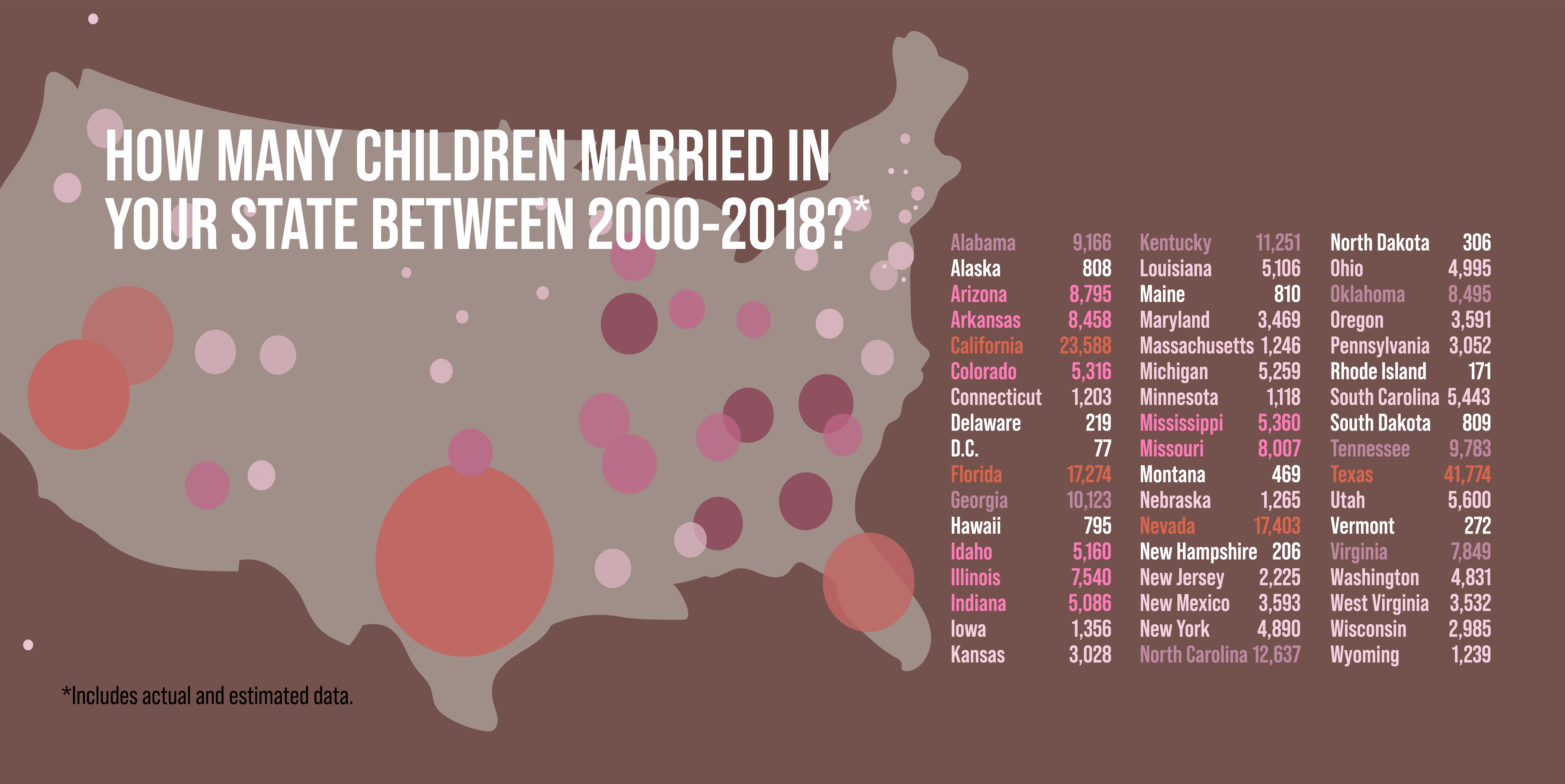
Unchained requested marriage-age data, based on marriage certificates, from all 50 states and the District of Columbia. Specifically, Unchained asked for de-identified data on the ages and genders of all people married in the state, along with their spouse’s age and gender, in each year since 2000.
Unchained retrieved marriage-certificate (or, in some states, marriage-license) data from 32 states that showed the age or age ranges of all individuals married each year between 2000 and 2018. For those states, Unchained analyzed the data to determine how many individuals married before age 18. (A few states provided data for 2019 and part of 2020 as well, but Unchained did not include those years in its national calculations.)
Note that Unchained counted children married, not child marriages. Thus, if a minor married another minor, Unchained counted that as two.
Some states provided data that conflicted with data they previously had provided to Unchained. For those states, Unchained used the newer data, on the assumption that the states had found and corrected errors.
Some states’ data included obvious gaps that mean Unchained’s findings are almost certainly an undercount. For example, Tennessee withheld all counts less than 10 (such as if nine 17-year-olds married 20-year-olds one year), potentially hiding thousands of additional child marriages, and Ohio randomly and irretrievably deleted data on children married before age 15 in most years. Additionally, some states’ data included nonsensical marriage ages, such as three-digit numbers, that Unchained excluded from its analysis.
Unchained confirmed all outliers in the data – that is, children listed as married before age 12 – by contacting the relevant state.
For 10 states and the District of Columbia, Unchained retrieved marriage-age data for some or most of the years 2000 to 2018. Since the number of children married in each state was highly correlated across years – the correlation ranged from .93 to .99 – Unchained used each of those states’ available data to estimate numbers for the missing years.
For two additional states (Nevada and Arizona), Unchained retrieved full marriage-age data from one county or a pair of counties that represented at least two-thirds of the state population.
To estimate data for the remaining six states and the remaining sections of Nevada and Arizona, Unchained looked for correlations between available marriage-age data in other states and variables in the American Community Survey, the U.S. Census Bureau’s demographics survey program. Unchained identified a strong correlation of .88 with a combination of two ACS variables: already-married individuals age 15 to 17 (they self-reported as married, divorced, widowed or separated) and divorced or separated individuals age 18 to 24. (See Appendix B for a breakdown of which states fit into each methodology category.)
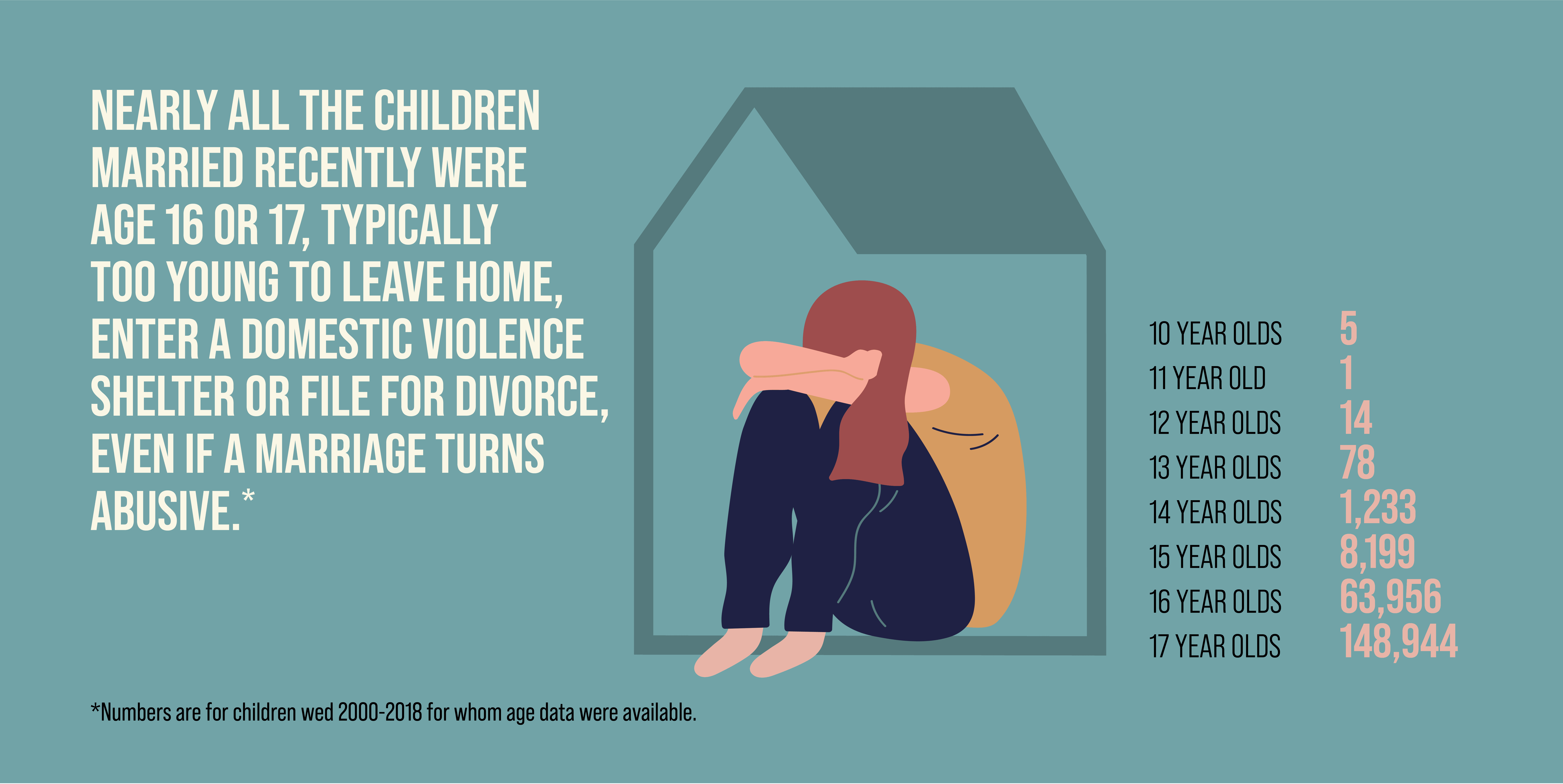
An estimated 297,033 children were married in the U.S. between 2000 and 2018.
That number includes 232,474 based on actual data plus 64,559 based on estimates.
Child marriage occurred most frequently among 16- and 17-year olds.
Some 96% of the children wed were age 16 or 17, though a few were as young as 10 [5].
10-Year-Olds: 5 (<1%)
11-Year-Olds: 1 (<1%)
12-Year-Olds: 14 (<1%)
13-Year-Olds: 78 (<1%)
14-Year-Olds: 1,223 (<1%)
15-Year-Olds: 8,199 (4%)
16-Year-Olds: 63,956 (29%)
17-Year-Olds: 148,944 (67%)
Child marriage is much more likely to impact girls than boys.
Some 86% of the children who married were girls – and most were wed to adult men (age 18 or older) [6]. Further, when girls married, their average spousal age difference was four years, whereas when boys married, their average spousal age difference was less than half that: 1.5 years [7].
Child marriage often covers up child rape.
Some 60,000 marriages since 2000 occurred at an age or spousal age difference that should have been considered a sex crime [8].
In about 88% of those marriages, the marriage license became a “get out of jail free” card for a would-be rapist under state law that specifically allowed within marriage what would otherwise be considered statutory rape.
In the other 12% of those marriages, the state sent a child home to be raped. The marriage was legal under state law, but sex within the marriage was a crime.
The 10 states with the highest per-capita rates of child marriage [9] are:
1. Nevada (0.671%)
2. Idaho (0.338%)
3. Arkansas (0.295%)
4. Kentucky (0.262%)
5. Oklahoma (0.229%)
6. Wyoming (0.227%)
7. Utah (0.208%)
8. Alabama (0.195%)
9. West Virginia (0.193%)
10. Mississippi (0.182%)
The national number of children married decreased almost every year but is unlikely to get to zero without legislative intervention.
2000: 76,396
2001: 35,809
2002: 20,542
2003: 18,867
2004: 17,033
2005: 16,871
2006: 14,191
2007: 12,710
2008: 11,421
2009: 10,325
2010: 9,102
2011: 22,361
2012: 6,962
2013: 5,933
2014: 4,943
2015: 4,275
2016: 3,695
2017: 3,104
2018: 2,493
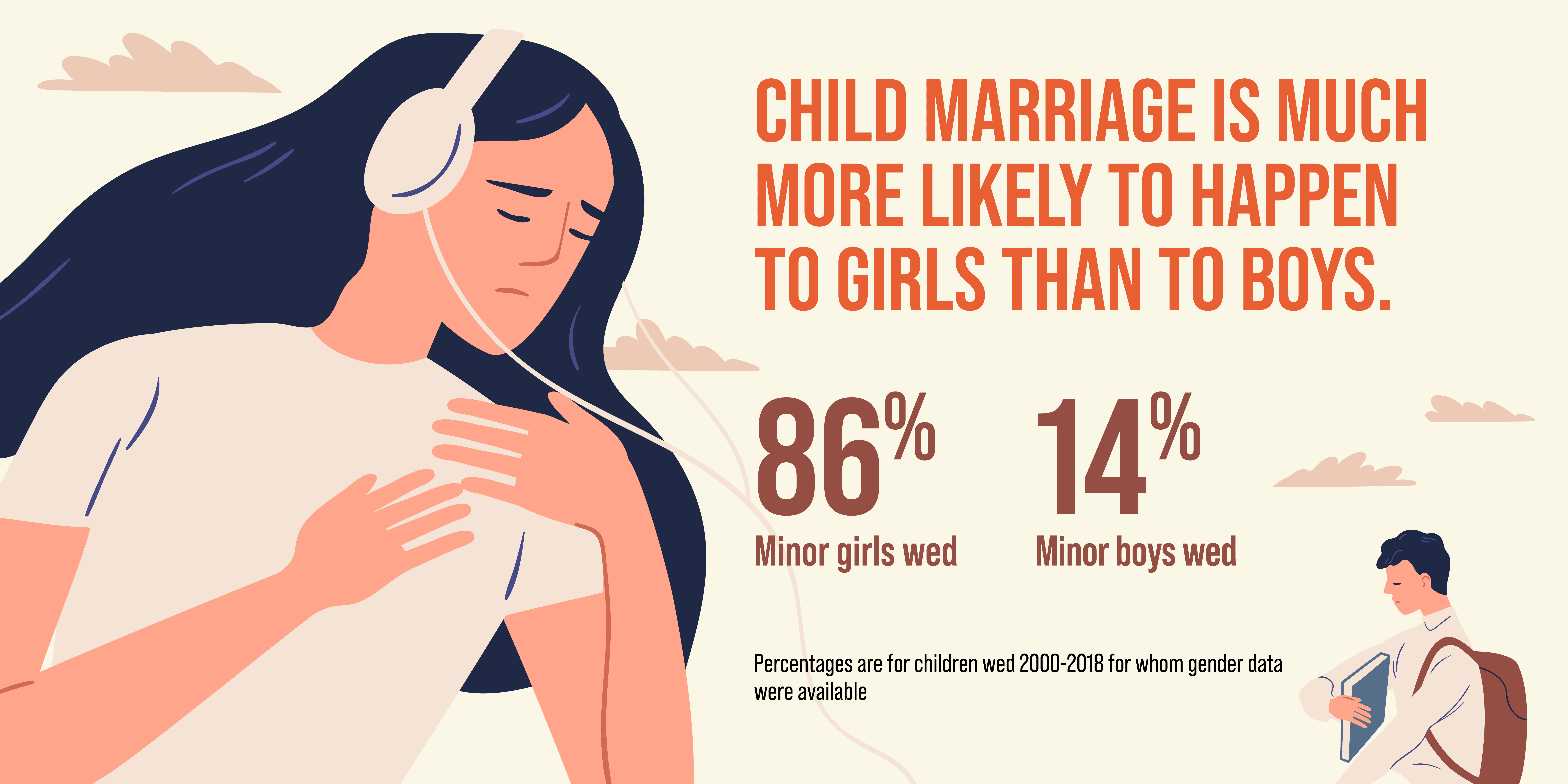
Policymakers should be deeply concerned about child marriage – including at age 16 or 17 – for three main reasons:
1. Child marriage can easily be forced marriage.
Minors, even highly mature 16- or 17-year-olds, do not have the legal rights they need to navigate a contract as serious as marriage.
Leaving home: Minors who leave home to escape from an abusive spouse or impending forced marriage are typically considered runaways under state law. Police might return them to their homes against their will; in some states, minors can be charged with a status offense for running away. Police might even arrest an advocate at Unchained who helped a minor leave home.
Entering a shelter: A minor who manages to run away from a forced marriage probably has nowhere to go, since Unchained has found that most domestic violence shelters do not accept unaccompanied minors. Youth shelters are not a solution: They typically notify parents their children are there, and house children only for about 21 days while they work on a reunification plan.
Retaining an attorney: Contracts with children, including retainer agreements with attorneys, usually are voidable under state law. Only the most generous attorneys would agree to represent a child.
Filing for divorce: Perhaps most shockingly, children typically are not allowed to initiate a legal proceeding – such as seeking a protective order or filing for divorce – unless they act through a guardian or other representative, under state law.
Some states have tried to close these legal traps by automatically emancipating minors upon their marriage. However, such emancipation arrives too late to prevent a child from being forced to marry; the child must undergo the trauma of the forced marriage before getting the limited legal rights that emancipation brings. And an emancipated minor’s rights are limited: Such a minor still might face difficulties leaving home, entering a shelter or taking other steps to escape an unwanted marriage. Further, automatic emancipation likely ends parents’ financial obligation to their child, regardless of the child’s financial situation. Unchained has seen such teens end up homeless after their marriage failed and their parents refused to allow them back home.
When children reach out to Unchained to ask for help escaping a forced marriage and learn about their limited options, many despair and turn to suicide attempts. Death seems like the only way out for them.
2. Child marriage is a human rights abuse that destroys American girls’ lives.
Marriage before 18, including at 16 or 17, is a human rights abuse, according to the U.S. State Department [10]. It produces devastating, lifelong repercussions for American girls, destroying their education [11], economic opportunities [12] and health [13]. It significantly increases a woman’s risk of experiencing domestic violence [14]. It almost always ends in divorce [15].
Much less is known about the impact of child marriage on American boys. Since most of the children who marry in the U.S. are girls, the research on the impacts of child marriage has been focused on girls.
3. Child marriage undermines statutory rape laws.
In most states and under federal law [16], sex with a child that would otherwise be considered rape – in some cases, felony rape – becomes legal within marriage. In those situations, the marriage license becomes a “get out of jail free” card for a child rapist.
In some states, statutory rape remains a crime within marriage. The marriage is legal, but sex within the marriage is rape. In those situations, the state that issues the marriage license sends a child home to be raped.
As this study showed, 60,000 marriages since 2000 occurred at an age or spousal age difference that should have been considered a sex crime – and 88% gave a rapist a “get out of jail free” card, while 12% sent a child home to be raped. Either way, the state made a mockery of its statutory rape laws.
Child marriage brings no benefit, other than to child rapists. A mature 17-year-old who is in love and wants to marry can wait a matter of months to marry without suffering any harm. A teen couple that gets pregnant can easily co-parent outside of marriage until they are both 18 (establishing paternity is a simple process in most states). A child who is in an abusive home deserves resources and options that do not involve entering a contractual sexual relationship.
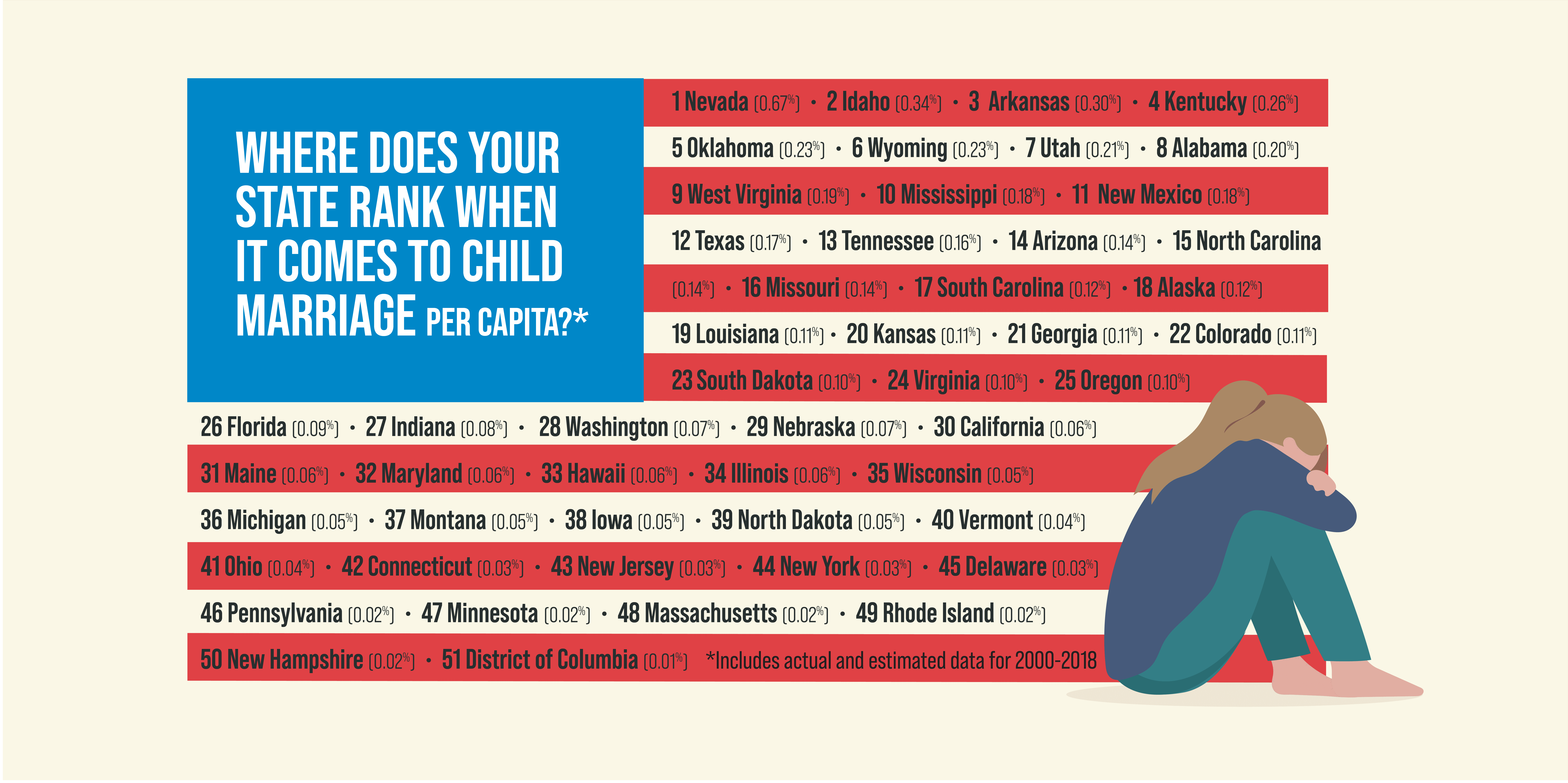
Unlike in countries such as India, where child marriage is illegal but remains stubbornly widespread due to other factors, the problem in the U.S. is the laws themselves. The nearly 300,000 children wed in the U.S. between 2000 and 2018 all were married legally.

Each U.S. state sets its own marriage age. While most states set it at 18, legal loopholes in most states still allow children to marry, typically with nothing more than a parent’s signature on a form (parental “consent” that is often actually parental “coercion” [17]) and/or a court’s approval (often a rubber stamp [18]). Five states’ laws still specifically allow pregnant girls to marry,* a loophole that has been used to cover up rape and force girls to marry their rapist [19].
Until 2018 – nearly the entire period covered by this study – child marriage was legal in every U.S. state, territory and district. Currently, child marriage remains legal in 46 states, three territories [20] and the District of Columbia, and 10 states’ laws still do not specify any minimum age for marriage** [21]. (See Appendix C for the youngest age at which one may marry in each U.S. state.)
one may marry in each U.S. state.)
Federal law, too, allows and might even encourage child marriage. The Immigration and Nationality Act does not specify any minimum age to petition for a foreign spouse or fiancé(e) or to be the beneficiary of a spousal or fiancé(e) visa [22]. This creates a significant incentive to force a child to marry a foreign adult who wants a U.S. visa, and it invites the trafficking of children to the U.S. under the guise of marriage.
U.S. Citizenship and Immigration Services approved 8,868 petitions involving minors for spousal or fiancé(e) entry into the U.S. between 2007 and 2017. The younger party was a girl in 95% of the petitions [23].

Additionally, the federal criminal code, which prohibits sex with a child age 12 to 15, specifically exempts those who first marry the child*** [24]. Refusing to punish child rapists who first marry the child encourages both child marriage and child rape.
Four states and two territories have passed legislation to end all marriage before 18, without exceptions: Delaware [25], New Jersey [26], Pennsylvania [27] and Minnesota [28], as well as American Samoa [29] and U.S. Virgin Islands**** [30]. (Puerto Rico banned marriage before age 18 in 2020 [31]. However, the age of adulthood in Puerto Rico is 21, so Puerto Rico cannot end child marriage unless it sets the marriage age at 21 or lowers the age of adulthood to 18.)
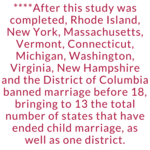
But other states have rejected or watered down legislation to end child marriage, in some cases eliminating one loophole only to introduce a new one, and some states have not acted at all. Bills to eliminate child marriage currently are pending in 12 states, but some have stalled.
Federal legislation to set a minimum age of 18 to remove marriage-related immigration benefits, except Violence Against Women Act self-petitions, for those under 18, was introduced in 2019 but did not get enough support to move [32].
The U.S. is one of 193 countries that have pledged, under the United Nations Sustainable Development Goals (specifically, SDG 5.3) to end child marriage by year 2030 to help achieve gender equality [33]. The U.S. and the world will not be able to keep this promise if legislators do not act now.
Every U.S. state, territory and district must pass simple, commonsense legislation to eliminate any legal loophole that allows marriage before age 18 (or higher, in the three states where the age of adulthood is higher [34]).
Additionally, the federal government must set a minimum age of at least 18 to petition for a spousal or fiancé(e) visa or to be the beneficiary of such a visa, and must eliminate the marital exception to statutory rape.*
Legislation to this effect harms no one except child rapists, costs nothing and protects children from a human rights abuse.
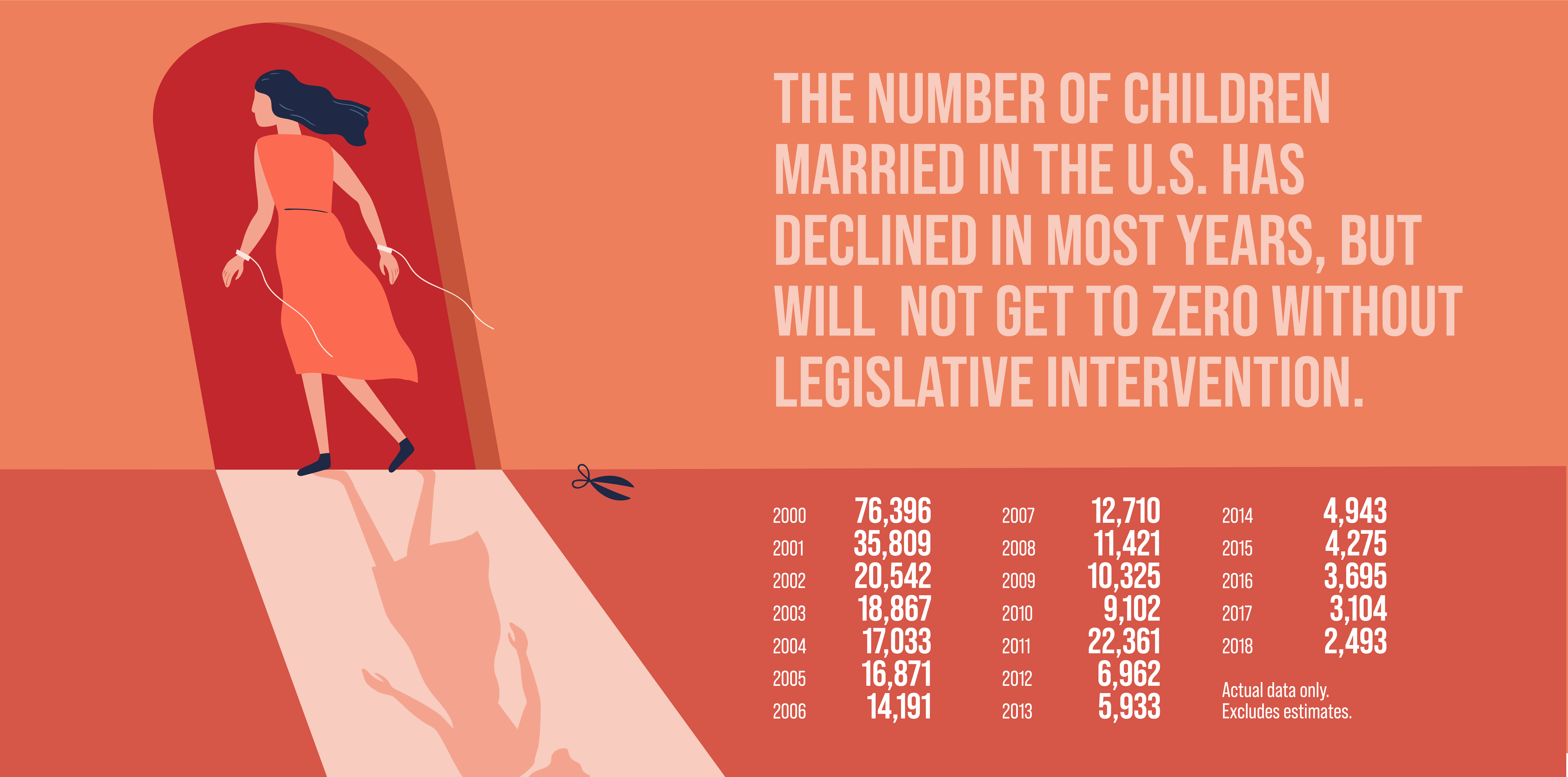
Unchained’s partners for this study included:
| Marriage-Certificate Data Retrieved 2000-2018 |
Partial Marriage-Certificate Data Retrieved (Years) | Partial Marriage-Certificate Data Retrieved (Counties) | No Marriage-Certificate Data Available | |
| 1 | Alabama | Dist. of Columbia (2010-2018) | Arizona (Pima, Maricopa) | Arizona (Outside Pima, Maricopa) |
| 2 | Alaska | Illinois (2000-2016) | Nevada (Clark*) | California |
| 3 | Arkansas | Indiana (2000-2004, 2010-2018) | Minnesota | |
| 4 | Colorado | Louisiana (2000-2016) | Nevada (Outside Clark) | |
| 5 | Connecticut | Maine (2017-2018) | New Mexico | |
| 6 | Delaware | New York (2000-2010) | North Carolina | |
| 7 | Florida | Oregon (2000-2014) | Oklahoma | |
| 8 | Georgia | Rhode Island (2013-2018) | Pennsylvania | |
| 9 | Hawaii | Texas (2000-2017) | ||
| 10 | Idaho | Utah (2000-2010) | ||
| 11 | Iowa | Washington (2000-2014) | ||
| 12 | Kansas | |||
| 13 | Kentucky | |||
| 14 | Maryland | |||
| 15 | Massachusetts | |||
| 16 | Michigan | |||
| 17 | Mississippi | |||
| 18 | Missouri | |||
| 19 | Montana | |||
| 20 | Nebraska | |||
| 21 | New Hampshire | |||
| 22 | New Jersey | |||
| 23 | North Dakota | |||
| 24 | Ohio | |||
| 25 | South Carolina | |||
| 26 | South Dakota | |||
| 27 | Tennessee | |||
| 28 | Vermont | |||
| 29 | Virginia | |||
| 30 | West Virginia | |||
| 31 | Wisconsin | |||
| 32 | Wyoming |

The youngest age* at which one may marry in each state [35]:

[1] Fraidy Reiss, America’s Child-Marriage Problem, New York Times (13 October 2015), https://www.nytimes.com/2015/10/14/opinion/americas-child-marriage-problem.html.
[2] David Lawson et al., What Does the American Public Know About Child Marriage?, PLoS ONE (23 September 2020), https://doi.org/10.1371/journal.pone.0238346.
[3] Fraidy Reiss, Why Can 12-Year-Olds Still Get Married in the United States?, Washington Post (10 February 2017), https://www.washingtonpost.com/posteverything/wp/2017/02/10/why-does-the-united-states-still-let-12-year-old-girls-get-married.
[4] Anjali Tsui et al., Child Marriage in America, PBS Frontline (6 July 2017), http://apps.frontline.org/child-marriage-by-the-numbers.
[5] Numbers and percentages based on children wed for whom age data were available (actual data only, excluding estimates).
[6] Percentages are based on children wed for whom spousal age and gender data were available (actual data only, excluding estimates).
[7] Calculations of spousal age differences are based on McGill University’s analysis of Unchained’s data (actual data only, excluding estimates) in 43 states.
[8] McGill University’s analysis of Unchained’s data found 34,943 to 40,224 marriages since 2000 occurred at an age or with a spousal age difference that should have constituted a sex crime under the relevant state’s law. In some 80%, sex became legal within marriage; in the other 20%, sex within the marriage was a crime. Unchained added to the analysis the estimated 23,588 children married in California between 2000 and 2018, all of whom fit in the first category.
[9] Per-capita comparison is based on actual and estimated data.
[10] U.S. Department of State, et al., United States Global Strategy to Empower Adolescent Girls (March 2016), https://2009-2017.state.gov/documents/organization/254904.pdf.
[11] Vivian Hamilton, The Age of Marital Capacity: Reconsidering Recognition of Adolescent Marriage, William & Mary Law School Scholarship Repository (2012), http://scholarship.law.wm.edu/cgi/viewcontent.cgi?article=2467&context=facpubs.
[12] Gordon Dahl, Early Teen Marriage and Future Poverty, The National Bureau of Economic Research (May 2005), http://www.nber.org/papers/w11328.pdf.
[13] Yann Le Strat, Caroline Dubertret, Bernard Le Foll, Child Marriage in the United States and Its Association With Mental Health in Women, Pediatrics: Official Journal of the American Academy of Pediatrics (24 August 2011), http://pediatrics.aappublications.org/content/pediatrics/early/2011/08/24/peds.2011-0961.full.pdf.
[14] World Policy Analysis Center, Fact Sheet (March 2015), https://www.worldpolicycenter.org/sites/default/files/WORLD_Fact_Sheet_Legal_Protection_Against_Child_Marriage_2015.pdf.
[15] Vivian Hamilton, The Age of Marital Capacity: Reconsidering Recognition of Adolescent Marriage, William & Mary Law School Scholarship Repository (2012), http://scholarship.law.wm.edu/cgi/viewcontent.cgi?article=2467&context=facpubs.
[16] 18 U.S.C. § 2243 calls for up to 15 years in prison and/or a fine for someone who has sex with a child age 12 to 15, if the child is at least four years younger.
[17] In Unchained’s experience, even when a minor shows up sobbing at the clerk’s office while their parents force them to marry, the clerk is unwilling or unable to intervene.
[18] In Unchained’s experience, minors being forced to marry are too scared to tell the judge about it. Additionally, this study shows judges across the U.S. have approved marriages for children who are too young to consent to sex. Further indication that judges are not paying close attention is a report that showed Massachusetts probate judges approved 92% of child marriage petitions between 2010 and 2014. See Jim Morrison, Advocates Raise Concerns About Child Marriage in Mass., Boston Globe (10 August 2016), https://www.bostonglobe.com/metro/2016/08/10/advocates-raise-concerns-about-child-marriage/sx4TQNbXp4gimy502yWB4L/story.html.
[19] The five states with a pregnancy exception to the marriage age are Arkansas (Arkansas Code Annotated § 9-11-103), Maryland (Maryland Family Law Code Ann. § 2-301), New Mexico (New Mexico Code § 40-1-6), North Carolina (North Carolina General Statutes § 51-2.1) and Oklahoma (Oklahoma Statutes Ann. § 43-3). For an example of how pregnancy loopholes have been used to cover up rape and force girls to marry their rapist, see: Nicholas Kristof, 11 Years Old, a Mom, and Pushed to Marry Her Rapist in Florida, New York Times (26 May 2017), https://www.nytimes.com/2017/05/26/opinion/sunday/it-was-forced-on-me-child-marriage-in-the-us.html. (CORRECTION: A previous version of this study said that four states as of April 2021 included a pregnancy exception to the marriage age, which excluded Arkansas. This was corrected as of April 2022.) *NOTE* After this study was completed, North Carolina changed its laws, reducing to four the number of states with a pregnancy exception to the marriage age: Arkansas, Maryland, New Mexico and Oklahoma.
[20] Puerto Rico banned marriage before age 18 in 2020 with PC1564. See https://sutra.oslpr.org/osl/esutra/MedidaReg.aspx?rid=124126. However, the age of adulthood in Puerto Rico is 21, so Puerto Rico cannot end child marriage unless it sets the marriage age at 21 or lowers the age of adulthood to 18. *NOTE* After this study was completed, Rhode Island, New York, Massachusetts, Vermont, Connecticut, Michigan, Washington and Virginia ended child marriage. Now child marriage is legal in 37 states, and four states do not specify a minimum marriage age.
[21] The 10 states whose laws do not specify any minimum age for marriage are California, Massachusetts, Michigan, Mississippi, New Mexico, Oklahoma, Rhode Island, Washington, West Virginia and Wyoming. *NOTE* After this study was completed, Rhode Island, Massachusetts, Michigan and Washington, which previously did not specify a minimum age for marriage, ended child marriage. Additionally, Wyoming and West Virginia raised their age to 16 from 0. Currently, four states’ laws do not specify a minimum marriage age: California, Mississippi, New Mexico and Oklahoma.
[22] 8 U.S.C. § 1101.
[23] U.S. Senate Committee on Homeland Security and Governmental Affairs, How the U.S. Immigration System Encourages Child Marriages (11 January 2019), https://www.hsgac.senate.gov/imo/media/doc/Child%20Marriage%20staff%20report%201%209%202019%20EMBARGOED.pdf.
[24] 18 U.S.C. § 2243 calls for up to 15 years in prison and/or a fine for someone who has sex with a child age 12 to 15, if the child is at least four years younger. *NOTE* The Violence Against Women Reauthorization Act of 2022 — which President Biden signed into law in March 2022 — eliminated this marriage defense to statutory rape. However, another marriage defense to statutory rape remains in the federal code under 10 U.S.C. § 920b.
[25] HB337 (2018). https://legis.delaware.gov/BillDetail?LegislationId=26363.
[26] S427 (2018). https://www.njleg.state.nj.us/2018/Bills/AL18/42_.HTM.
[27] HB360 (2020). https://www.legis.state.pa.us/cfdocs/billInfo/billInfo.cfm?sYear=2019&sInd=0&body=H&type=B&bn=0360.
[28] HF745 (2020). https://www.revisor.mn.gov/bills/bill.php?f=HF745&y=2019&ssn=0&b=house.
[29] HB35-28 (2018). Not available online.
[30] Bill No. 33-109 (2020). https://www.legvi.org/billtracking/Detail.aspx?docentry=27003.
[31] PC1564 (2020). https://sutra.oslpr.org/osl/esutra/MedidaReg.aspx?rid=124126.
[32] S.742/H.R.1738: Protecting Children Through Eliminating Visa Loopholes Act (2019-2020). https://www.congress.gov/bill/116th-congress/senate-bill/742/text and https://www.congress.gov/bill/116th-congress/house-bill/1738/all-info.
[33] United Nations Sustainable Development Goal 5 is to “achieve gender equality and empower all women and girls.” One aspect of that, Goal 5.3, is to “eliminate all harmful practices, such as child, early and forced marriage and female genital mutilation.” https://sdgs.un.org/goals/goal5.
[34] The age of adulthood is 19 in Alabama (Code of Alabama, Title 26, Chapter 1, § 26-1-1); 21 in Mississippi (Mississippi Code Ann. § 1-3-27); and 19 in Nebraska (Nebraska Code § 43-2101).
[35] Marriage age is based solely on statute, not on case law. *NOTE* After this study was completed, Rhode Island, New York, Massachusetts, Vermont, Connecticut, Michigan, Washington and Virginia ended child marriage. (The youngest marriage age allowed in those states is now 18.) Additionally, North Carolina and Alaska raised their marriage age to 16 from 14, Maryland raised its age to 17 from 15, Maine raised its age to 17 from 16, and Wyoming and West Virginia raised their age to 16 from 0.
© 2021 Unchained At Last
Legislative information on this page is accurate as of April 2021.